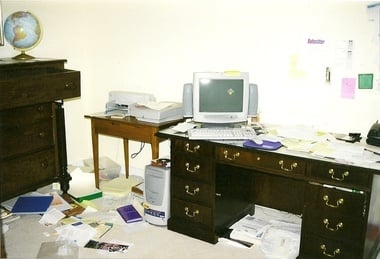For those of you who already have the good habit of corralling and processing paper daily, keep up the good work! Being conscious of the daily flow of paper and deliberately controlling its flow is the only way to win the war on paper. A casual approach to paper is a guarantee that you’ll create your own personal paper nightmare. Paper is relentless in its flow into your space. You need to be relentless in your handling of it. Do it daily! It really only takes minutes! Minutes of agony or boredom are better than the hours and hours of excavation that will be required if you procrastinate and let paper accumulate. Here’s what I mean by PROCESS PAPER DAILY: Make sure paper follows a specific route, a paper path.
Paper should not float from room to room. When paper comes into the house, make sure it lands in one spot to be sorted into categories instead of allowing it to land in any one of a number of different locations. If you decide the kitchen counter is that spot, make sure everyone in your family knows that mail always lands on the kitchen counter. After being sorted, make sure the different categories of paper are immediately moved to their next logical location. Bills, for example, would go to the bill paying area. Once the bills are paid, the paper associated with them would then be filed or pitched. So, the paper path for a bill would be: from the mailbox to the kitchen counter; from the kitchen counter to the desk of the home office where the bill is paid; from the desk to the filing cabinet. It’s important to create paper paths for every category of paper you regularly handle. To simplify this process, consider having all paper move from its sorting location to a home office where the different categories can be processed and stored if necessary. That way the path would be: from the mailbox to the kitchen counter for sorting; from the kitchen counter to the home office desktop for review and action; from the the desktop to the filing cabinet or the recycle bin. Making papers follow specific paths puts you in charge of paper instead of feeling at the mercy of paper. Your work is to determine the paths and to discipline yourself to make paper follow those paths every time. Just one lapse in maintaining your new paper system can cause paper to spiral out of control. Remember, digging out takes much more time and energy than maintaining paper paths! It will take over if you let it stray from a defined route.
Sort incoming papers into categories. I recommend these categories: trash; refer out to someone else; action; filing; reading; holding for later reference or action; and possibilities of things to do, buy, etc. It’s best to separate the action category into bills and other actions. That way you are less likely to lose sight of your bills. Distribute papers by category to their appropriate locations. For example, trash goes to the recycling bin or trash can. Action papers are moved to the desk or countertop where action will take place. Filing is either filed or stored in a filing tray until you make time to file. Reading is taken to the location where you do your reading, perhaps a basket on your desk or next to the sofa. You’ll notice I don’t recommend that you complete all the tasks associated with those papers on a daily basis. That would take more time than you have every day. I am just recommending that you control the flow of paper coming in, sort it and distribute it to the place where it will be acted upon or stored. If you do that much paper processing every day, you will find your stress goes down and your productivity goes up. You’ll be in charge of paper instead of feeling at the mercy of it!
